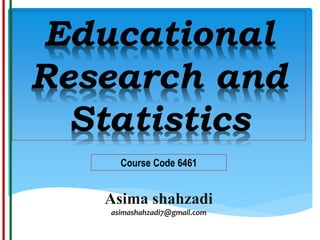
Unit 6 sampling techniques
- 1. Educational Research and Statistics Course Code 6461 Asima shahzadi asimashahzadi7@gmail.com
- 3. A population is the entire group that you want to draw conclusions about. A sample is the specific group that you will collect data from. The size of the sample is always less than the total size of the population. Population vs sample: what’s the difference?
- 5. Populations are used when your research question requires, or when you have access to, data from every member of the population. Usually, it is only straightforward to collect data from a whole population when it is small, accessible and cooperative. Example: Collecting data from a population. A high school administrator wants to analyze the final exam scores of all graduating seniors to see if there is a trend. Since they are only interested in applying their findings to the graduating seniors in this high school, they use the whole population dataset. Collecting data from a population
- 6. When your population is large in size, geographically dispersed, or difficult to contact, it’s necessary to use a sample. You can use sample data to make estimates or test hypotheses about population data. Example: Collecting data from a sample. You want to study political attitudes in young people. Your population is the 300,000 undergraduate students in the Netherlands. Because it’s not practical to collect data from all of them, you use a sample of 300 undergraduate volunteers from three Dutch universities – this is the group who will complete your online survey. Collecting data from a sample
- 7. 1. Necessity: Sometimes it’s simply not possible to study the whole population due to its size or inaccessibility. 2. Practicality: It’s easier and more efficient to collect data from a sample. 3. Cost-effectiveness: There are fewer participant, laboratory, equipment, and researcher costs involved. 4. Manageability: Storing and running statistical analyses on smaller datasets is easier and reliable. Reasons for sampling
- 8. Sampling errors happen even when you use a randomly selected sample. This is because random samples are not identical to the population in terms of numerical measures like means and standard deviations. Because the aim of scientific research is to generalize findings from the sample to the population, you want the sampling error to be low. You can reduce sampling error by increasing the sample size. Sampling error
- 9. It is the process of selecting a sample from the population. For this population is divided into a number of parts called Sampling Units. Sampling
- 10. 1. Large population can be covered. 2. Time, money and energy is saved. 3. Helpful when units of area are homogenous. 4. Used when percent accuracy is not acquired. 5. Used when the data is unlimited. Need For Sampling
- 11. Probability A probability sample is one in which each member of the population has an equal chance of being selected. In-probability sampling, randomness is the element of control. For example, in a population of 1000 members, every member will have a 1/1000 chance of being selected to be a part of a sample. Probability sampling eliminates bias in the population and gives all members a fair chance to be included in the sample.. Probability Sampling
- 12. Reduce Sample Bias: Using the probability sampling method, the bias in the sample derived from a population is negligible to non-existent. The selection of the sample mainly depicts the understanding and the inference of the researcher. Probability sampling leads to higher quality data collection as the sample appropriately represents the population. Diverse Population: When the population is vast and diverse, it is essential to have adequate representation so that the data is not skewed towards one demographic. For example, if Square would like to understand the people that could make their point- of-sale devices, a survey conducted from a sample of people across the US from different industries and socio-economic backgrounds helps. Createan AccurateSample: Probability sampling helps the researchers plan and create an accurate sample. This helps to obtain well-defined data. Uses of probability sampling
- 13. Non-probability Sampling in a non-probability sample, a particular member of the population being chosen is unknown. In non-probability sampling, it relies on personal judgment Non-probability Sampling
- 14. Create a hypothesis: Researchers use the non-probability sampling method to create an assumption when limited to no prior information is available. This method helps with the immediate return of data and builds a base for further research. Exploratory research: Researchers use this sampling technique widely when conducting qualitative research, pilot studies, or exploratory research. Budget and time constraints: The non-probability method when there are budget and time constraints, and some preliminary data must be collected. Since the survey design is not rigid, it is easier to pick respondents at random and have them take the survey or questionnaire. Uses of non-probability sampling
- 15. convenience sampling: is the process of selecting participants who are easily obtainable. E.G: M.C higher Secondary school. quotasampling: using convenience sampling, with the restriction that the sample has the same % of each subgroup. snowball sampling They told two friends, and so on, and so on... Types Of Non-probability Sampling
- 19. clustersampling: certain groups are randomly sampled & all subjects in them are observed Randomsampling allocates participants from the population of interest in such a way that each member of the population has an equal chance of being selected. Systematic Sampling Each member of the sample comes after an equal interval from its previous member. For Example, for a sample of 50 students, the sampling fraction is 50/800=1/8 i.e. select one student out of every eight students in the population. The starting points for the selection is chosen at random. Types of Probability Sampling